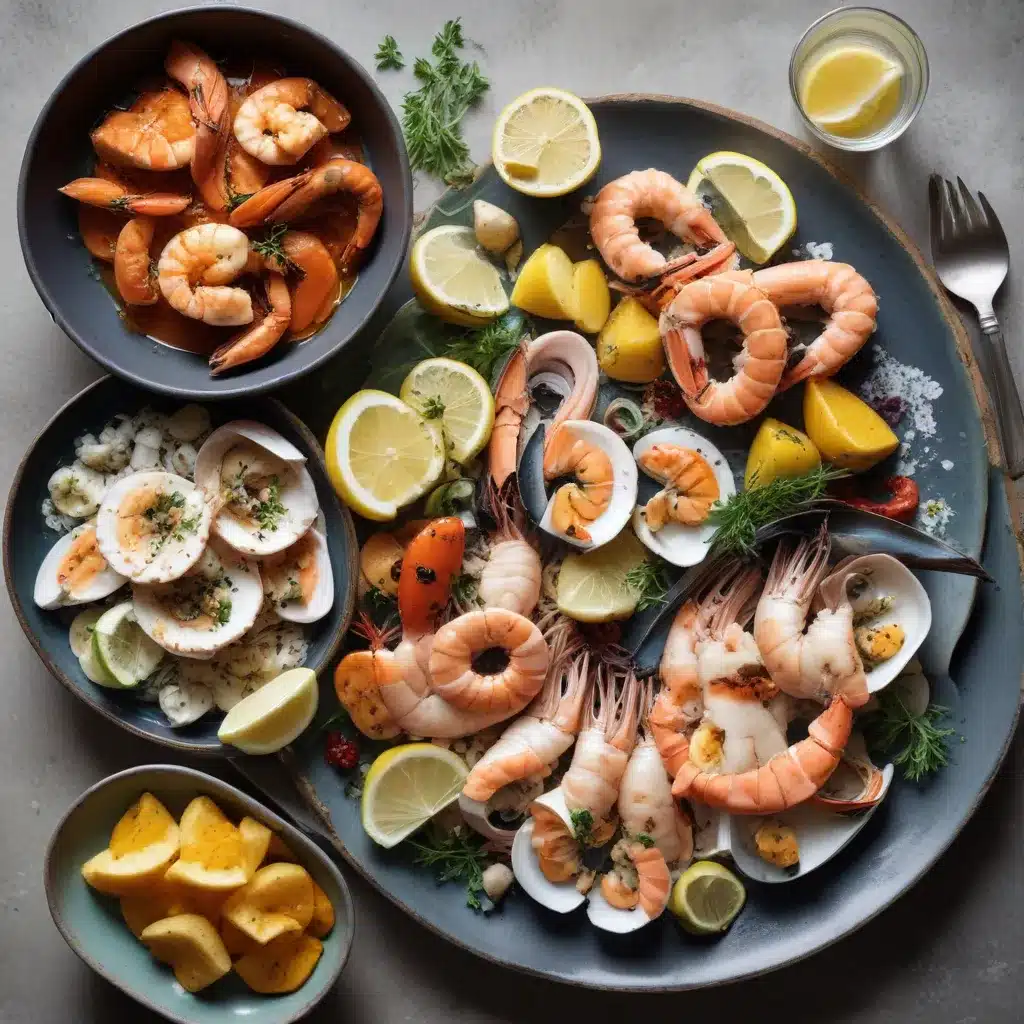
Seafood Pairing Fundamentals
When it comes to the world of seafood, a true connoisseur understands that the art of pairing goes far beyond simply selecting the perfect wine. From delicate cod fillets to briny oysters, each type of seafood has its own unique flavor profile that must be thoughtfully considered. Proper storage and preparation also play a crucial role in unlocking the full potential of these underwater delicacies.
Seafood Storage Essentials
The key to maintaining the freshness and integrity of seafood lies in proper storage techniques. Cod, for example, should be refrigerated at 32-34°F and used within 3 days of purchase. Delicate shellfish like oysters and mussels need to be stored in the coldest part of the refrigerator, ideally in a perforated container or mesh bag to allow for air circulation. Improper handling or storage can quickly lead to off-flavors and spoilage, so it’s essential to familiarize yourself with the unique requirements of each seafood item.
Flavor Profiles and Pairings
Once you’ve mastered the art of seafood storage, it’s time to explore the world of flavor pairings. Cod, with its mild, slightly sweet taste, pairs beautifully with bright, acidic ingredients like lemon, white wine, or a classic mignonette sauce. In contrast, oily fish like salmon or mackerel benefit from rich, creamy accompaniments that can balance their robust flavors.
Achieving Flavor Harmony
The true mark of a seafood pairing master is the ability to create a harmonious balance of flavors. This may involve incorporating complementary ingredients, such as pairing a delicate ceviche with a crisp, citrusy white wine, or elevating a simple grilled cod fillet with a vibrant, herb-infused sauce. By understanding the interplay of flavors, you can craft seafood dishes that truly sing on the palate.
Seafood Preparation Techniques
Proper handling and cooking methods are essential for unlocking the full potential of seafood. Improper preparation can quickly lead to tough, dry, or overly fishy results, which can compromise the overall dining experience.
Proper Handling and Cleaning
When it comes to seafood, cleanliness is paramount. Cod fillets should be gently rinsed and patted dry before cooking, while shellfish require a more thorough cleaning process to remove any dirt or sand. Familiarize yourself with the appropriate techniques for each type of seafood to ensure a flawless final result.
Cooking Methods for Optimal Taste
The method of cooking can also have a significant impact on the flavor and texture of seafood. Gentle techniques like poaching, steaming, or en papillote (baking in parchment paper) can preserve the delicate qualities of cod or sole, while searing or grilling can add a delightful caramelized crust to salmon or tuna. Experiment with different cooking methods to find the perfect approach for each seafood variety.
Seasoning and Marinades
The right seasoning can make all the difference in a seafood dish. A simple lemon-herb marinade can elevate a plain cod fillet, while a spicy Cajun-style rub can transform shrimp into a flavor-packed experience. Explore a variety of herbs, spices, and sauces to find the perfect flavor profile for your seafood creations.
Pairing Seafood with Complementary Ingredients
Seafood shines when paired with the right supporting cast of ingredients. From vibrant vegetables to aromatic herbs and grains, the possibilities for flavor exploration are endless.
Vegetable Companions
Crisp, fresh vegetables can provide a delightful contrast to the richness of seafood. Asparagus, Brussels sprouts, or fennel can all make excellent pairings with cod or halibut, while roasted beets or grilled zucchini complement the heartiness of salmon or tuna.
Herb and Spice Accents
The addition of fragrant herbs and spices can elevate a seafood dish to new heights. Dill, parsley, or tarragon provide a bright, herbaceous note that complements cod or scallops, while cumin, paprika, or chili powder can add a touch of heat and depth to shrimp or mussels.
Starch and Grain Pairings
Seafood also thrives when paired with hearty starches and grains. Creamy risotto or buttery mashed potatoes can provide a comforting base for salmon or halibut, while nutty farro or fluffy quinoa can balance the richness of seared tuna or grilled octopus.
Balancing Flavors in Seafood Dishes
The true mastery of seafood pairing lies in the ability to strike a harmonious balance between the various flavor components. By understanding the interplay of acidity, richness, and umami, you can create seafood dishes that are both visually stunning and a delight to the palate.
Acidity and Brightness
Seafood often benefits from a touch of acidity to brighten and balance its natural flavors. Lemon, lime, or white wine can provide a refreshing counterpoint to cod or scallops, while pickled vegetables or vinegar-based sauces can enhance the briny qualities of oysters or mussels.
Richness and Texture
To offset the delicate nature of some seafood, incorporating rich, creamy elements can create a satisfying contrast. Creamy risotto, buttery hollandaise, or velvety beurre blanc can elevate halibut or salmon to new levels of indulgence.
Umami and Savory Notes
The addition of umami-rich ingredients can lend depth and complexity to seafood dishes. Soy sauce, miso, or mushrooms can amplify the natural savory notes of tuna or mackerel, while roasted garlic or caramelized onions can complement the sweetness of cod or shrimp.
By mastering the art of seafood pairing, you can unlock a world of culinary possibilities. Whether you’re crafting a simple cod fillet or an elaborate ceviche platter, the key lies in understanding the unique flavor profiles of each ingredient and how they can harmoniously come together to create a truly memorable dining experience. So, let your culinary exploration begin and discover the endless possibilities of seafood pairing.

